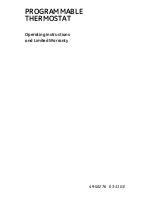
45
Refrigeration Maintenance
NOTE: The following procedures involve servicing the refrigeration system. Some of these service procedures are regu-
lated by Federal, and in some cases, by State and Local laws.
All regulated refrigeration service procedures must be performed by an EPA certified technician, using approved equip-
ment and complying with all Federal, State and Local laws.
REFRIGERANT CHARGE
Charging the Refrigeration System
The receiver tank sight glass allows the operator to deter-
mine the amount of charge under established operating con-
ditions. These units can be damaged by an overcharge of
refrigerant. The amount of refrigerant the system can hold
depends on circuit volume which is affected by hose length.
The most satisfactory method of charging the engine-driven
compressor circuit and the electric standby driven compres-
sor circuit is:
1.
Connect a gauge manifold to the engine-driven com-
pressor and receiver tank.
2.
Connect the center hose of the gauge manifold to the
manifold of an evacuation station.
3.
Connect the hose form a drum of refrigerant to the
manifold of the evacuation station. Make sure the valve
on the refrigerant drum is closed.
4.
Open the valves on the gauge manifold and the valves
on the evacuation station.
5.
Start the vacuum pump and evacuate the system to 500
microns. After the system reaches 500 microns, evacu-
ate the system for an additional hour.
NOTE: If the system will not come down to 500
microns, there is probably a leak in the system or in
the evacuation and charging equipment hoses. Find
and repair the leak.
6.
After the additional hour of evacuation, close the valve
at the evacuation pump, stop the vacuum pump, and
observe the reading on the vacuum gauge for 5 min-
utes. The pressure should not exceed 2000 microns.
NOTE: If it does, repeat steps 4 and 5. This time if the
pressure exceeds 2000 microns within 5 minutes, look
for a leak in the system or in the evacuation and
charging equipment hoses. Find and repair the leak.
7.
Open the vacuum valve at the vacuum pump, start the
vacuum pump and evacuate the system to 500 microns.
8.
When the system reaches 500 microns, close the
vacuum valve at the evacuation station manifold. The
system is now ready to charge.
9.
Close the low side valve on the gauge manifold, leave
the high side valve on the gauge manifold open, and
open the valve on the refrigerant drum to delivery
liquid.
10. Allow 5 lb (2.3 kg) of refrigerant to enter the system.
Then close the valve on the refrigerant drum and the
high side valve on the gauge manifold.
11. Start the unit on engine operation, set the thermostat at
0 F (-20 C), and run the unit in cool until the box tem-
perature approaches 0 F (-20 C).
12. Make sure that the unit is running in cool, the compres-
sor is running at approximately 1000 rpm, the suction
pressure is 2 to 8 psig (14 to 55 kPa), and the head pres-
sure is at least 180 psig (1241 kPa) for R-134a systems
and 275 psig (1896 kPa) for R-404A. If necessary, raise
the head pressure by covering the condenser.
13. With these conditions established, open the low side
valve on the gauge manifold and open the valve on the
refrigerant drum to deliver liquid.
14. Observe the receiver tank sight glass. When the ball in
the receiver tank sight glass reaches the top of the sight
glass, close the valve on the refrigerant drum.
Содержание 914 724
Страница 4: ......
Страница 8: ......
Страница 14: ...4...
Страница 16: ...6...
Страница 25: ...Unit Description Rev 1 99 15 1 Fan 2 Thermometer Sensor 3 Thermostat Sensor Evaporator 1 2 3 AGA358...
Страница 32: ...22...
Страница 38: ...28...
Страница 98: ...88...
Страница 107: ...97 Model 10 and 20 Schematic Diagram...
Страница 108: ...98 Model 10 Wiring Diagram...
Страница 109: ...99 Model 20 Wiring Diagram...
Страница 110: ...100 Model 20 Single Phase with Heat Option Schematic Diagram...
Страница 111: ...101 Model 20 Single Phase Wiring Diagram...
















































